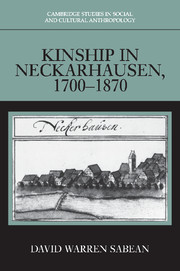Book contents
- Frontmatter
- Contents
- List of tables
- Abbreviations
- Abbreviations of sources
- On reading kinship diagrams
- Glossary
- Preface
- Introduction
- Cohort I (1700–1709)
- Cohort II (1740–1749)
- Cohort III (1780–1789)
- Cohort IV (1820–1829)
- Cohort V (1860–1869)
- 17 Kinship in the mid-nineteenth-century village: An introduction
- 18 Networking with kin around the mid nineteenth century
- 19 Matrifocal alliance
- Conclusion
- Appendix
- Bibliography
- General index
- Index of villagers
19 - Matrifocal alliance
Published online by Cambridge University Press: 04 August 2010
- Frontmatter
- Contents
- List of tables
- Abbreviations
- Abbreviations of sources
- On reading kinship diagrams
- Glossary
- Preface
- Introduction
- Cohort I (1700–1709)
- Cohort II (1740–1749)
- Cohort III (1780–1789)
- Cohort IV (1820–1829)
- Cohort V (1860–1869)
- 17 Kinship in the mid-nineteenth-century village: An introduction
- 18 Networking with kin around the mid nineteenth century
- 19 Matrifocal alliance
- Conclusion
- Appendix
- Bibliography
- General index
- Index of villagers
Summary
During the fifth, sixth, and seventh decades of the nineteenth century, many families had been in alliance for well over a century. Despite the convergence in marital strategy between Bauern and artisans, families continued to differ according to the amount of property they had accumulated. Even within the same stratum, however, certain families seemed to be obsessed with forming consanguineal unions. Almost all sibling groups in the sample contracted at least one kin-linked marriage, but some of them made a remarkable number of them – two contracting seven each (Tables A.72, A.73)! During this period, the practice of marrying kin substantially increased in frequency, to reach the highest rate of any period discussed so far (25 percent, 39 percent, 29 percent, 26 percent, and 49 percent, respectively). Consanguineal marriages were not practiced before the 1740s, but then they increased in both absolute and relative terms through and beyond the middle decades of the nineteenth century.
The statistical evidence from the cohort (Tables A.74, A.75) demonstrates that both Bauern and artisans made more kin marriages than ever before. By contrast, most in the new group of factory workers made no such alliances at all. Since this study does not go beyond 1870, nothing is known of their fortunes, but it could be that like the artisans of the eighteenth century, they delayed a generation before conforming to the dominant practice.
- Type
- Chapter
- Information
- Kinship in Neckarhausen, 1700–1870 , pp. 379 - 396Publisher: Cambridge University PressPrint publication year: 1997



